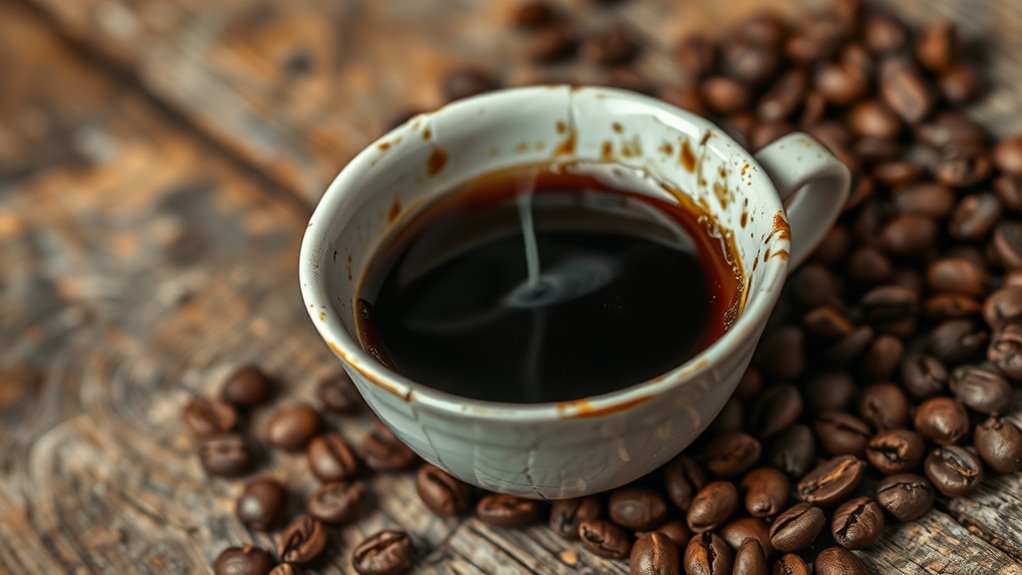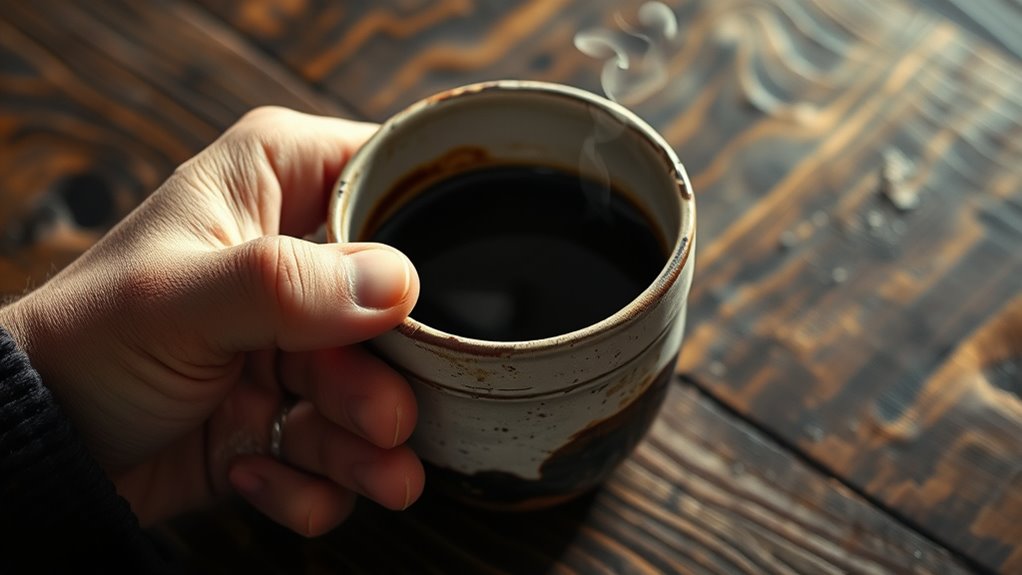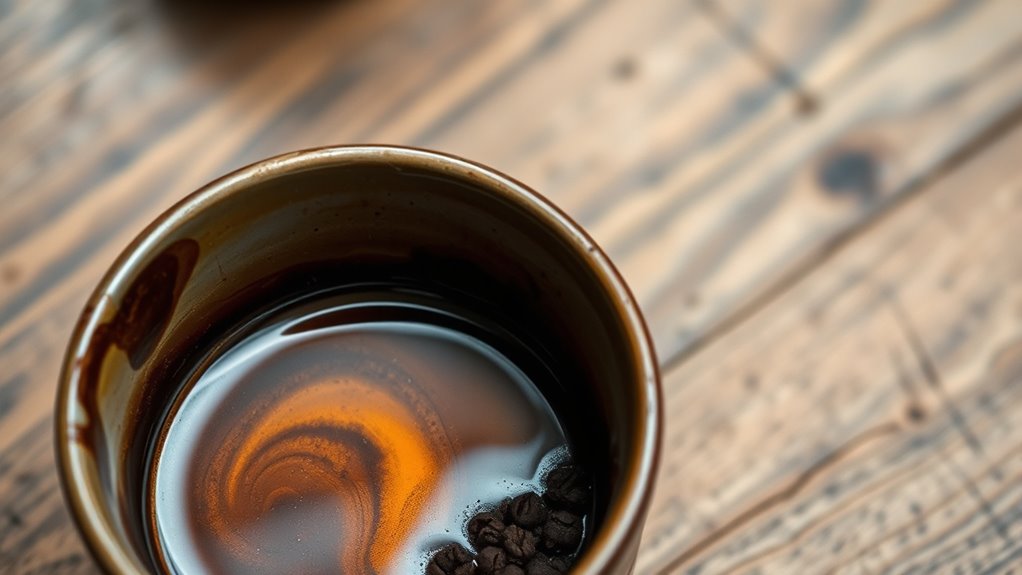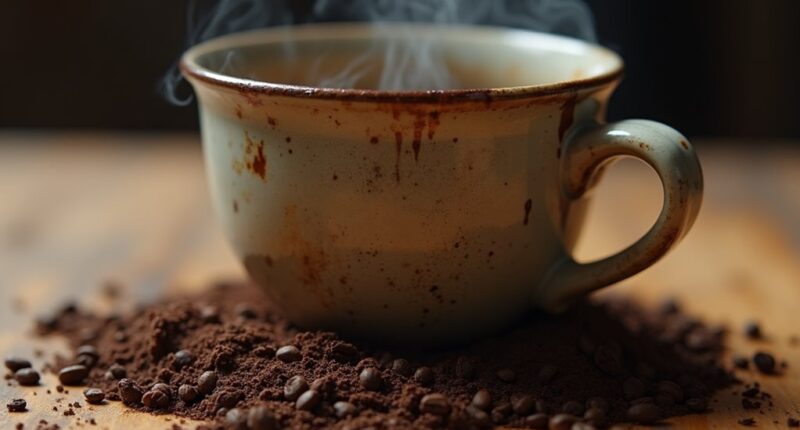Old coffee’s like that friend who never shows up to the party; it leaves you feeling disappointed! It tastes flat and boring with no vibrant flavors left. The aroma’s dull and sometimes even musty, while the texture? It’s all thin and crunchy—yikes! You might get weird tastes like bitterness or even burnt notes. It’s a sad sip, for sure. If you’re curious about what makes coffee fresh and tasty, stick around to hear more!
At a Glance
- Old coffee often tastes flat and boring due to diminished flavor intensity and breakdown of flavor molecules.
- The aroma of stale coffee becomes dull, sometimes presenting musty notes that detract from the experience.
- Mouthfeel is usually thin and lacks the richness that fresh coffee provides, leading to a less satisfying sip.
- Common off-flavors like bitterness or burnt notes may emerge, negatively impacting the overall taste profile.
- Visual and tactile indicators, such as brittle beans or brownish hues, signal that the coffee has aged poorly.
Chemical and Physical Changes in Old Coffee

When you think about old coffee, you might imagine that it just sits there, getting stale and sad. But there’s more to it!
The oxidation effects break down those lovely flavor molecules and oils, making your brew taste flat. Plus, enzymatic changes mess with the beans, turning vibrant acidity into bitterness.
As time rolls on, you’ll notice color fading and beans getting brittle. They might even lose weight!
And let’s not forget those volatile compounds that disappear, leaving you with a sad cup. Proper coffee storage techniques can significantly slow these changes and help preserve the quality of your beans.
Sensory Profile of Stale Coffee
Old coffee might be undergoing a fascinating transformation, but that doesn’t mean it’s turning into a magical elixir! Instead, it’s more like a sad, muted version of itself. You’ll notice the flavor intensity is lacking, leaving your cup flat and, honestly, a bit boring. The aroma? Dull, with maybe a musty note hanging around. You might even find it feels thin on your tongue, like it’s lost its soul. And that aftertaste? Yikes! It can be bitter or just plain forgettable. Fresh coffee delivers a rich sensory experience, while stale just doesn’t cut it. Ground coffee freshness is key to maintaining that delightful flavor profile, so keep those beans fresh, friends!
Visual and Tactile Indicators

Ever noticed how coffee beans can tell you a story just by looking at them?
When you spot those brownish hues on older beans, that’s visual deterioration waving a flag. Fresh beans feel smooth and slightly oily, but old ones? They can be brittle, with a crunchy texture that screams, “I’m past my prime!”
Tactile sensations play a big part too; if they feel sticky, those oils have gone rogue. You might even find cracks or a dusty residue, reminding you they’ve seen better days. Proper storage techniques can help maintain the freshness of your coffee beans longer.
Common Off-Flavors and Defects
If you’ve ever sipped a cup of coffee that tasted more like a cardboard box than your favorite morning brew, you know what I’m talking about.
Those off-flavors, like baggy or burnt notes, can ruin your day. Coffee freshness really matters! Underdeveloped beans might remind you of grass, while overdeveloped ones taste like charred toast.
Then there are metallic flavors from dirty machines or poor-quality beans. Yikes!
To avoid these coffee mishaps, stick to fresh beans from trusted roasters and keep your equipment clean. Additionally, selecting the finest coffee grounds can elevate your brewing experience. You deserve a cup that’s delicious, not an adventure in bad taste!
Impact of Storage and Age

When you crack open a bag of coffee, it’s like releasing a little bit of magic—until that magic starts to fade away.
You see, age effects really come into play after a month or two. The vibrant flavors you love? They start to dull.
To keep your coffee fresh, try smart storage techniques like vacuum sealing or keeping it in an airtight container. Stash it in a cool, dark place, away from moisture and heat. The quality of your water used for brewing can also significantly impact the overall taste of your coffee.
Treat your coffee like a treasure; the better you store it, the longer you can savor that flavor-packed experience with friends. Cheers to fresh brews!
Myths and Exceptions
Storing your coffee like a pro is just the beginning of the journey—let’s bust some myths about old coffee taste!
First off, old coffee isn’t universally bitter; it’s all about extraction levels, not just age.
And guess what? Aroma sticks around longer than you think!
Myth debunking shows us some aged beans can taste fantastic, especially if you tweak your brewing method.
Freshness isn’t everything; some coffees evolve beautifully over weeks.
In fact, certain low acid organic coffee varieties may even enhance their flavor profile over time.
So, don’t toss your beans just because they’re past their prime!





